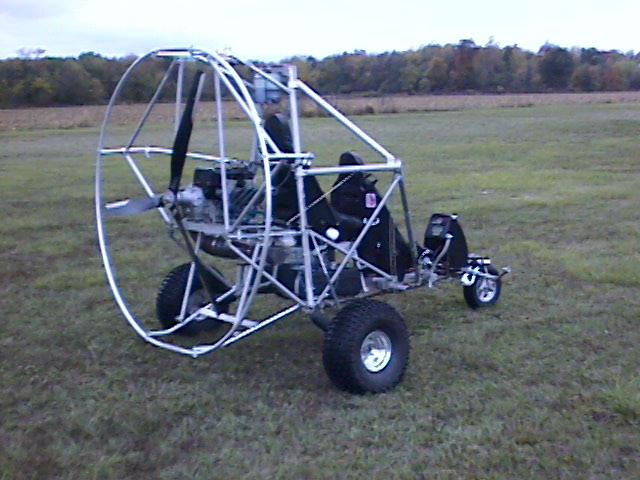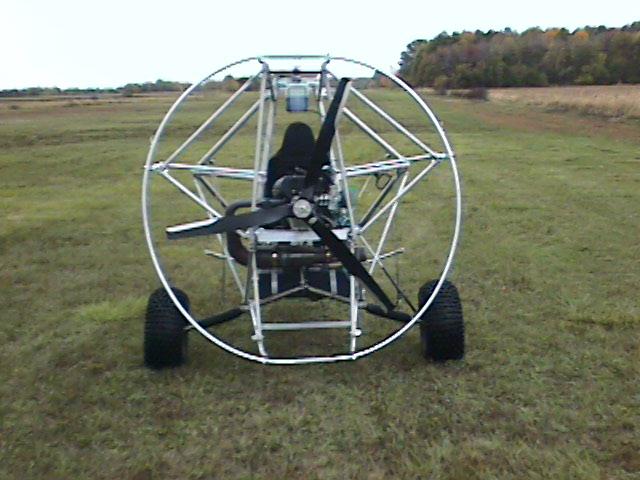The new Destiny PPC. Photos
and review by Bruce Pritchett
Today John Rivers brought a pre-production Destiny PPC to my place
for me to
fly and evaluate. He arrived about 1:30 pm, and the weather was
very
overcast. We did a thorough pre-flight on the machine, and he
showed me a
few changes he had made since the last time I had seen it. We
then headed
for the airfield. When we got there, it was pretty windy, but
not to the
point of being dangerous, so I decided to take it up for a spin.
The chute
kited up perfectly, and I took it to full throttle and was up in no
time.
However..... as soon as I left the ground, the wind started to pick
up, and
beat me around a LOT. I felt very uncomfortable being in a strange
machine
in strong winds, so I did a couple passes, and was back on the ground
within
about 5 minutes. I was concentrating too much on trying to get
the thing
safely on the ground to think much about how it was flying. We
decided to
head back to my house and go over some pricing.
After about an hour of spreadsheet work, my wife came in and said, "Hey,
it's beautiful out now!" She was right. It was about 5pm
and we had about
90 minutes of daylight left. We headed for a farm airstrip that
happened to
be on John's way home. When we got there, it was sunny and still.
Beautiful flying weather. We warmed up the Destiny and I flew
it for about
30 glorious minutes. Here's what I thought.
Pluses- The Destiny's strongest point is comfort. The high back
bucket seat
cradles you in an upright position in comfort I've never felt in my
Buckeye.
The wide racing harnesses are probably overkill, but they are comfortable
and secure feeling. The upright position is nice. The steering
bars are
bent, and your feet naturally gravitate right to the bend. Much
better than
straight bars. The steering is "no pulleys on the footbars",
much like
everything except a Buckeye. This translates into smooth easy
turns with
very little pressure required. THe down side is that you lose
some of the
real tight turning the Buckeye system gives you. The machine
has very
"macho" looks. The flight concepts chute kites well and flies
beautifully.
The machine is solid and well built, and should give passenengers (er,
students) a very comfortable ride. The tundra tires absorb a
HUGE amount of
shock. These tires, coupled with the stiff, heavy spring rods,
seem to work
very well together. Overall, it flew very, very well. Oh,
and EIS will be
standard on this PPC for somewhere around $12K!
Minuses - This being a prototype, there were a few fit-and-finish things
that need to be cleaned up, and some "extra" holes in the frame where
things
were relocated from. These will of course be cleaned up on production
machines. This unit sported a 503 Rotax with a tuned pipe. The
503 is not
enough engine for this sized machine, and I didn't like the tuned pipe
at
all. The pipe creates a "spikey" powerband which made smooth
landings very
difficult. I'd come in and "feather" the throttle to smooth it
out, and the
tuned pipe would kick in and jump 300 rpms. I ended up just bringing
it in
on a shallow glidepath and flairing it out with no throttle input.
Not as
smooth as if I'd have been able to feather the throttle, but not bad.
He
plans to go to a 65 hp Hirth, which will be VERY welcome, in my opinion.
Another minus was the steering. It works similar to Buckeye,
but is
backwards. I had a real hard time with this, since my intuition
kept taking
me the wrong way. This will be changed (to suit me, I'm sure!).
I also
felt the instrument pod was too tall. You can't even see the
front wheel.
I think I talked John into chopping that down some as well. We
talked about
a few other changes, but overall, it is attractive, well built, and
functional.
I am anxious to see and fly a production machine next. I am sold
on my
Buckeye, but I tell you, the comfort of this machine, coupled with
the
target price, make it very tempting to me!



|